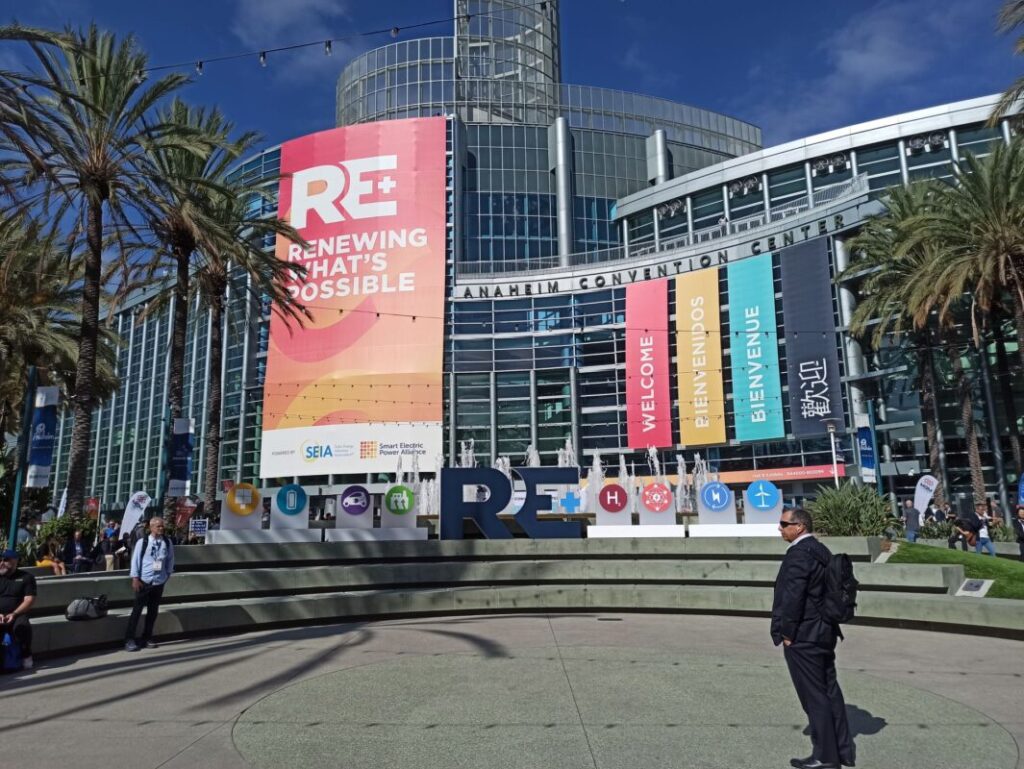
This year marked the 20th edition of North America’s largest solar and energy storage event, RE+. As the event closed its doors last week in Anaheim, California and before returning next September in Las Vegas, Nevada, PV Tech brings you some key talking points from the conversations we had with industry players.
With nearly 50,000 people from the industry gathering in the Anaheim Convention Center and its sun-soaked surroundings, PV Tech gathered a few insights from the myriad interviews and conversations we held last week before they appear in a longer format.
Unlock unlimited access for 12 whole months of distinctive global analysis
Photovoltaics International is now included.
- Regular insight and analysis of the industry’s biggest developments
- In-depth interviews with the industry’s leading figures
- Unlimited digital access to the PV Tech Power journal catalogue
- Unlimited digital access to the Photovoltaics International journal catalogue
- Access to more than 1,000 technical papers
- Discounts on Solar Media’s portfolio of events, in-person and virtual
The election could bring uncertainty
“There’s a stark policy contrast between the two presidential candidates. To me, that’s really what matters,” said Jon Powers, president of CleanCapital, a solar asset owner and investor headquartered in New York.
“The Harris administration has been pretty clear about continuing many of the Biden policies that have given that policy certainty which has allowed us to continue to scale. I believe in a Trump administration there will be a lot of uncertainty, whether it be his efforts to take pieces of the IRA or some of the trade issues, etc.
“We will continue to do well as an industry regardless; the trends are very clear. But there’s no doubt about it: that uncertainty will cause risk which will mean a higher cost of capital.”
Red state investment should shore up IRA
“The beauty of renewables is that it’s there everywhere, you can’t stop the sun from shining or the wind from blowing. Whether it’s in a Republican state or a Democratic state, it’s there everywhere,” said Sandhya Ganapathy, CEO of EDP Renewables North America.
“In fact, most of the Republican states have benefitted much more than the other states. When it comes to economic development, when it comes to jobs, when it comes to providing additional income to farmers, when it comes to property tax and the impact it can have on the community, I don’t think there’ll be any debate around whether you need renewables or not.”
Justin Johnson, COO of Arevon, agreed: “Everyone I’ve spoken to is pretty confident that the IRA, for the needs of everyone at this conference, is on a solid footing. They’re building the projects largely in red districts, the manufacturing is largely in red districts…I think when you get into the nitty-gritty, making sweeping changes to the IRA is going to quickly become unpopular with the majority of Congress.”
“Insatiable” corporate demand for community solar
Aaron Halimi, founder of Californian solar developer and owner Renewable Properties, told PV Tech: “There is insatiable demand. There is more demand from commercial and industrial (C&I) users [for community solar projects] than there are projects. If you talk to community solar subscriber companies they’ll tell you that they have more subscribers than they do projects [to supply them]. It’s a good thing.
“The reason why large tech companies and data centres are participating in community solar is that they are seeing substantial delays in the large utility-scale projects that they have historically procured power from. And in some markets, they may not be able to procure wholesale power, so community solar is another means for them to green their energy portfolio and consumption.”
Developers play geopolitical whack-a-mole
“The IRA’s helping but there’s so many more tailwinds and headwinds,” Justin Johnson, COO of US solar and storage developer Arevon, told us. “Are there going to be difficulties? Is AD/CVD a pain in the ass? Yeah. But is it any different to how we dealt with the UFLPA and WRO and COVID and Section 201?
“The industry’s persevered through all that stuff. It’s kind of like whack-a-mole, you just get creative. I got started in wind [power], and it was just Western and US suppliers for turbines and it was much easier; solar is ruled by geopolitics.
“A lot of people are really concerned about [the AD/CVD tariffs], saying it’s going to affect buildout. But I think the biggest thing affecting buildout is interconnection, these days. Panels are getting through, and there’s a cost risk but there are also ways around that. I just don’t see it affecting things in a big way.”
VPP to meet data centre demand growth today
“One thing I’m really excited about is we’ve just put out a public proposal to serve data centre demand growth driven by AI computing, and we’re calling it a master power purchase and dispatch agreement,” says Chris Rauscher head of grid services of virtual power plants (VPPs) at solar installer Sunrun.
“We really think that this structure can get out of some of the historic friction between residential solar companies and utilities, and can provide very fast, very flexible clean energy to data centres today. We’re talking a matter of months, not a matter of years.”
“If you’re talking about nuclear or something else, great. Those are necessary solutions, but those are going to take years, maybe decades. Whereas our distributed virtual power plant solution can be deployed today.”






